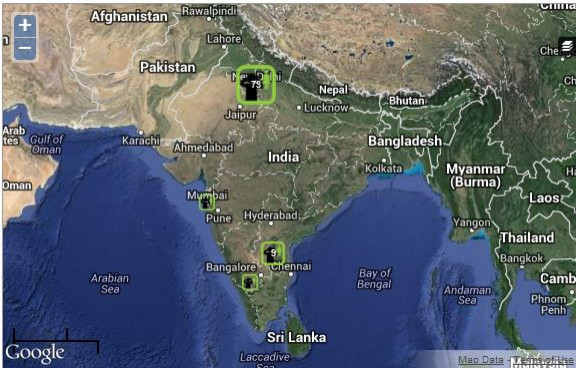'Rape Map': Indian Website SafeCity Seeks To Locate Most Dangerous Parts of Country For Women

India’s epidemic of rape and sexual assaults on women has triggered waves of outrage and despair across the subcontinent, but some tech-savvy young Indians have sought to help females by operating a website that seeks to identify “safe” and “unsafe” areas for the fairer sex in the vast country.
SafeCity.In, which was formed only days after the fatal gang-rape of a young medical student in Delhi in December 2012 made global headlines and sparked enormous protests across India, invites girls and women to report incidents of sexual harassment (anything from unwanted catcalls all the way up to rape). With this anecdotal evidence, the website’s creators – young entrepreneurs Alsa D’Silva, Saloni Malhotra, Surya Velamuri and Aditya Kapoor -- are able to draw an interactive, crowd-sourced map of India that highlights the most dangerous places for women.
Tech Crunch reported that SafeCity asks its contributors to state the type of incident that took place, as well as the time and location.
“Police reform, judicial reform, those are all great things, but given the population of the country, I don’t think the system can handle it,” D’Silva said. “We need new and innovative ways to facilitate a cultural shift. … People should start using data for their own protection and safety. It’s not possible to only rely on the government and police for solutions.”
Velamuri explained to BBC that her group’s aim was to customize the website “to Indian behavior so we included categories like cat-calling, touching and groping, sexual [invitations], indecent exposure, et cetera."
Statistics regarding rape in India are believed to be grossly underreported, largely owing to many victims’ unwillingness to enter into the glare of publicity as well as the indifference of many police officers. SafeCity seeks to account for the huge number of incidents that never even get reported.
Since the website’s debut, it has received almost 1,000 reports of sexual abuse, the overwhelming majority from the capital city of Delhi, where rape is extremely common.
"The map on our site can help in many ways. If you are a woman traveling to a new city, a look at the map will instantly tell you about the safe and unsafe locations," Velamuri added.
"Also, if we see lots of reports coming from a specific area in a city, it can actually help the police and administration nail the possible reasons that make it unsafe, like poor lighting, insufficient patrolling or the presence of [criminal] elements.” The service also provides women with the comfort of total anonymity.
“We realized that women in India are usually scared and [too] shy to report sexual abuse. They do not like their names and identities to be revealed, but here you can post as an anonymous user," Velamuri noted.
However, that leads to other problems – namely that such reports cannot be easily verified, nor can the police investigate unconfirmed assaults on anonymous victims. In response, Velamuri said they are working with police officials to find a way to enable victims to report such assaults to the authorities.
Yet another problem is that only about 10 percent of India’s population are Internet users – meaning that the vast majority of women, particularly in the poor rural areas, have little or no access to this system.
Moreover, it will be much harder to loosen centuries of gender-based sexual behavior and attitudes in India.
“One is the systemic issue of this being a part of our culture,” D’Silve told TechCrunch. “The men feel it’s their right to subject women, and if we stop allowing them, or giving them the liberty to do this, that’s the first step to change.”
On the SafeCity site itself, a woman from Goa (a resort area that has witnessed a number of high-profile rapes, particularly of Western tourists) recently wrote: “I was walking along the quiet road with a friend. A motorbike stopped beside us. A man jumped off the back of the motorbike and grabbed my breasts with his hand. He started pushing me (by my breasts) towards the side of the road aggressively. Luckily, he grabbed my bag and ran back to the motorbike. I was sure I would be raped and was so relieved when the man sped away on the motorbike.”
A foreign tourist wrote of an experience from a few years ago on a bus in the northern state of Uttar Pradesh: “In 2006 I was traveling with some friends on a bus from Jhansi to Khajuraho. At a stop, my friends went to the bathroom and left me alone for a few minutes. The bus driver came up to me as I was trying to lift a large bag. He asked if I was married which at the time I thought was strange. I said no (naively) and he grabbed my breast - I couldn't do much about it as I was struggling with the bag. I was so shocked I didn't really respond, and I didn't feel I could tell the police as no one else had seen the incident.”
© Copyright IBTimes 2024. All rights reserved.





















